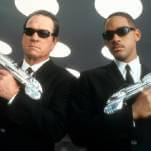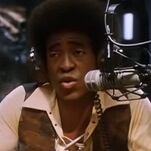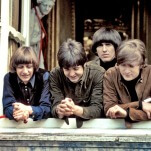Top Chef: "Taste Of The Five Boroughs"

Welcome once again to the Top Chef blog, as I take you through another season of scallop-searing, demi-glace drizzling fun, this time in New York City, the undisputed capital of America’s culinary world. Having dabbled around in Los Angeles, San Francisco, Miami, and Chicago through the first four seasons, the show’s move to New York was both inevitable and perhaps a sign that it needs a boost. In my view, there are few reality shows better than Top Chef, but all of them are slaves to formula and formulas are bound to grow stale, no matter how outrageous the personalities that fed through them. My worry about Season Five: Does Top Chef still have [insert cooking metaphor that’s synonymous to “sizzle” but less cheesy here]? Or has the whole thing gone [insert food metaphor that’s synonymous to “stale” but less cheesy here]?
So after some brief introductions—Jeffrey of the feathery hair, Radhika of the “I’m not going to be pigeonholed as the curry-and-rice Indian chef, here won’t you try my apple chutney” variety, the snooty Europeans—out come a whopping 17 hopefuls, roughly as many as the murderer’s row of economists that accompanied Barack Obama at his first press conference. And right off the bat, I’m wanting to whip out the machete and start hacking away at all the chaff: Culinary students, overachieving moms, caterers… don’t unpack your suitcases. You have no chance of winning, no matter how determined you are to prove otherwise. (Any time a contestant says, “I want to prove that [anyone other than seasoned chefs] can win this competition,” you can rest assured their time is limited.
The three-tiered Quickfire takes a cheeky approach to the whole “Big Apple” concept by having contestants cut apples for two rounds, then make a dish out of them for the third. The first round winnows the field to nine, the second to four, and the last one ends in a would-be Top Chef exiting before he or she even sees the inside of the kitchen or stumbles into the communal hot tub with a heaping glass of white wine. Now, I can understand people who might object over knife skills being the first challenge, but those people are wrong, I think. Knowing how to cut an apple with a knife strikes me as a skillset as fundamental as frying an egg, which has long been the simple standard chefs employ when looking for help on the line. I’d be willing to be that the four of the final five chefs in this competition were standing in the Top Nine after Round One. Not everyone can be Hung, mind—and based on her onion-chopping skills in Season Three, a strong chef like Casey would not make the cut—but I’d guess that a chef’s ability to work a knife speaks to experience and skill even more than a good dish would at this stage.
After two rounds—the second of which has them chopping their peeled apples brunoise-style—we’re left with four bottom-dwellers who are asked to throw together a 20-minute dish incorporating the fruit. Of the four, Leah stands out as by far the most talented, because she’s the one dish I’d like to eat: Seared scallops with an apple hash. The others are clearly doomed now or later, including Radhika, who makes a predictable (if well-liked) apple chutney, and culinary-school chums Patrick and Lauren, who race to last place together by making pedestrian salads. Lauren winds up going back to Savannah for a spinach salad with minimal inspiration, but Patrick doesn’t fare much better with his apple slaw.








































